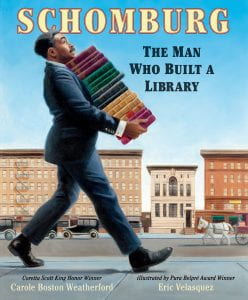 In luminous paintings and arresting poems, two of children’s literature’s top African-American scholars track Arturo Schomburg’s quest to correct history. Where is our historian to give us our side? Arturo asked. Amid the scholars, poets, authors, and artists of the Harlem Renaissance stood an Afro–Puerto Rican named Arturo Schomburg. This law clerk’s life’s passion was to collect books, letters, music, and art from Africa and the African diaspora and bring to light the achievements of people of African descent through the ages. When Schomburg’s collection became so big it began to overflow his house, he turned to the New York Public Library, where he created and curated a collection that was the cornerstone of a new Negro Division. A century later, his groundbreaking collection, known as the Schomburg Center for Research in Black Culture, has become a beacon to scholars all over the world. Ages 9–12.
In luminous paintings and arresting poems, two of children’s literature’s top African-American scholars track Arturo Schomburg’s quest to correct history. Where is our historian to give us our side? Arturo asked. Amid the scholars, poets, authors, and artists of the Harlem Renaissance stood an Afro–Puerto Rican named Arturo Schomburg. This law clerk’s life’s passion was to collect books, letters, music, and art from Africa and the African diaspora and bring to light the achievements of people of African descent through the ages. When Schomburg’s collection became so big it began to overflow his house, he turned to the New York Public Library, where he created and curated a collection that was the cornerstone of a new Negro Division. A century later, his groundbreaking collection, known as the Schomburg Center for Research in Black Culture, has become a beacon to scholars all over the world. Ages 9–12.
 The writers and illustrators of this English/Arabic bilingual picture book are Palestinian refugee children in the Aida Refugee Camp near the city of Bethlehem in the West Bank. They created a story that focuses on a boy in a refugee camp whose experiences reflect those of many Palestinian refugee children. The wall that led to this picture book was built in 2004 across the West Bank, home to more than a million Palestinians. This wall separates the refugee camp from the children’s old village and the land where their grandparents used to harvest. The Palestinian refugees call it a separation wall. In the story, a Palestinian boy recalls one spring when a high concrete wall was built next to his home. The construction of the wall brought threatening objects and people such as heavy machinery, guns, gas canisters, loud army jeeps, and heavily armed soldiers. The children’s playground is buried as the gray construction covers the springtime landscape. The new gigantic wall brings many concerns for the boy: his soccer field, places to pick flowers, his father’s safety in commuting to work in Jerusalem, and his turtle’s adjustment to a refugee camp. This hard-to-believe reality is conveyed through a poetic tone to the narration. Portraying the boy’s experiences and thoughts through conditional statements reflects the boy’s longing to go home, which is not physically far away from the camp, yet politically distant. The story ends with the mother telling her son and perhaps all Palestinian refugee children, “I hope you will become whatever you want to be, but for now I am very glad that you are my little boy. Sit with me under our tree, and I will sing to you of Jerusalem.” Ages 9 and up.
The writers and illustrators of this English/Arabic bilingual picture book are Palestinian refugee children in the Aida Refugee Camp near the city of Bethlehem in the West Bank. They created a story that focuses on a boy in a refugee camp whose experiences reflect those of many Palestinian refugee children. The wall that led to this picture book was built in 2004 across the West Bank, home to more than a million Palestinians. This wall separates the refugee camp from the children’s old village and the land where their grandparents used to harvest. The Palestinian refugees call it a separation wall. In the story, a Palestinian boy recalls one spring when a high concrete wall was built next to his home. The construction of the wall brought threatening objects and people such as heavy machinery, guns, gas canisters, loud army jeeps, and heavily armed soldiers. The children’s playground is buried as the gray construction covers the springtime landscape. The new gigantic wall brings many concerns for the boy: his soccer field, places to pick flowers, his father’s safety in commuting to work in Jerusalem, and his turtle’s adjustment to a refugee camp. This hard-to-believe reality is conveyed through a poetic tone to the narration. Portraying the boy’s experiences and thoughts through conditional statements reflects the boy’s longing to go home, which is not physically far away from the camp, yet politically distant. The story ends with the mother telling her son and perhaps all Palestinian refugee children, “I hope you will become whatever you want to be, but for now I am very glad that you are my little boy. Sit with me under our tree, and I will sing to you of Jerusalem.” Ages 9 and up.